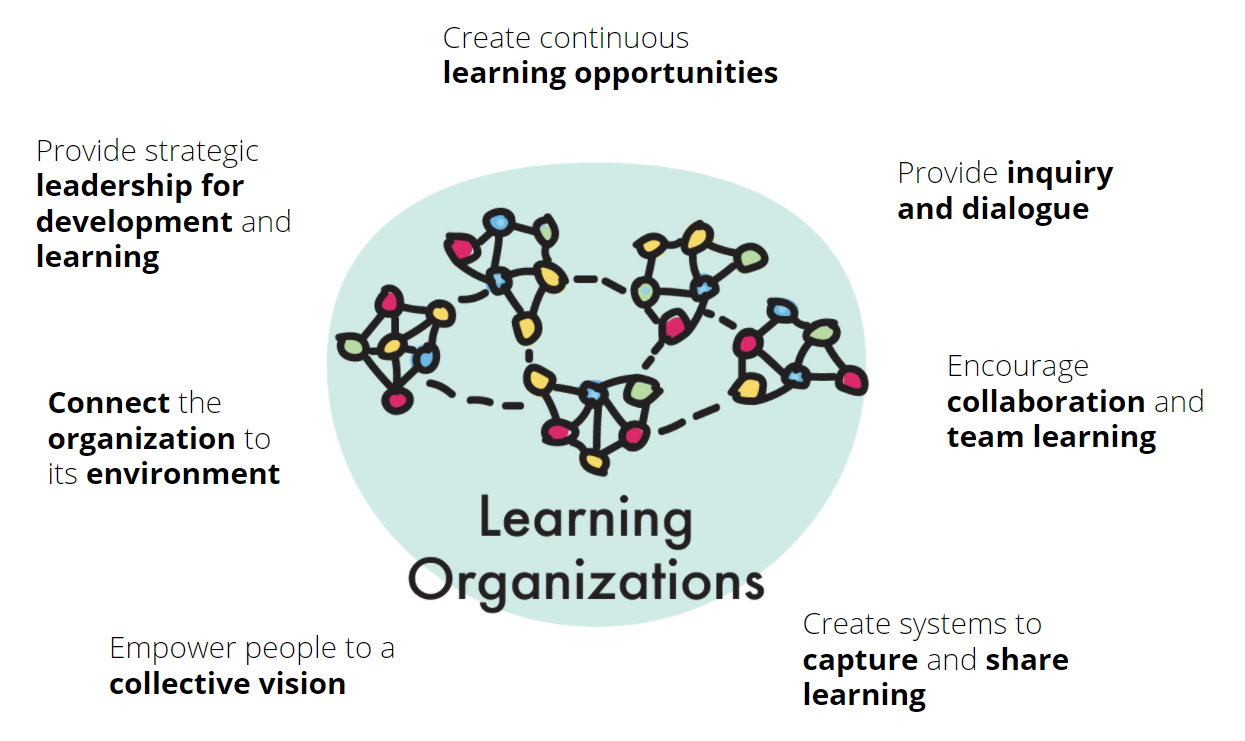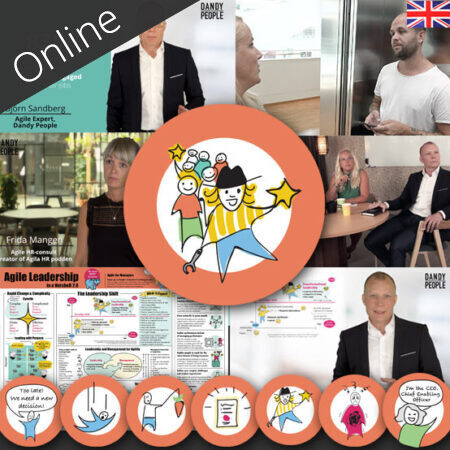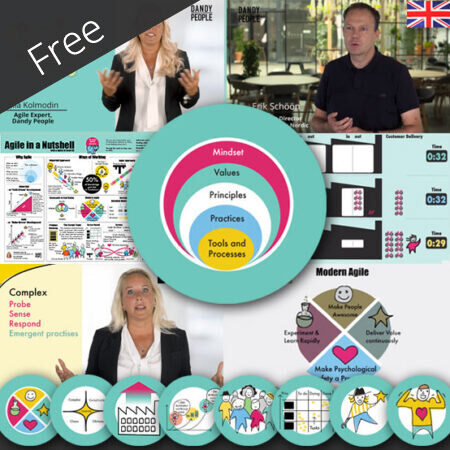This is the fourteenth episode of our Agile Leadership & Management Series.
During my years working mainly with team, leadership and organizational development, I have experienced so many organizations lacking skills to both find and use the power that comes out of learning. We just tend to study what we already know, where we already are. But that does not lead us anywhere new. We need to learn from other people and in other areas to move forward.
Continuous learning is one of the keystones to be thriving in whatever environment and/or task you set out for. Learning is at its best when it flows through all levels of the organization, from the individual, to the teams/groups and, all the way out through the different parts of the organization. And many organizations struggle to find ways to set this up to work in a successful way and make it fluent in everyday work. So here are some really great tips and tools to get your learning organization up and running.
Becoming a Learning Organization starts with empowerment, e.g., alignment and autonomy, which creates an environment where game-changing strategies can emerge from people at the operational levels.
So, what are the prerequisites for this to happen?
Check out the graphic below to find the prerequisites to uncover 7 proven strategies for embedding learning into your organization.

The 7 Prerequisites for a Learning Organization
Individual level
- 1. Create Continuous Learning Opportunities
Learning is designed to work so that people can learn on the job; opportunities are provided for ongoing education and growth. - 2. Promote inquiry and dialogue
People gain productive reasoning skills to express their views and the capacity to listen and inquire into the views of others; the culture is improved to support questioning, feedback, and experimentation even more.
Team/Group level
- 3. Encourage Collaboration and Team Learning
Work is designed to use teams/groups to access different modes of thinking; teams/groups are expected to learn and work together; collaboration is valued by the culture and rewarded.
Organizational level
- 4. Create Systems to Capture and Share Learning
Both high– and low-technology systems to share learning are created and integrated with work; access is provided; systems are maintained. - 5. Empower people toward a collective vision
People are involved in setting, owning, and implementing a joint vision; responsibility is distributed close to decision making so that people are motivated to learn toward what they are held accountable to do.
People are involved in setting, owning, and implementing a joint vision; responsibility is distributed close to decision making so that people are motivated to learn toward what they are held accountable to do. - 6. Connect the organization to its environment
People are helped to see the effect of their work on the entire enterprise; people scan the environment and use the information to adjust work practices; the organization is linked to its communities. - 7. Provide Strategic Leadership for Learning
Leaders model, champion, and support learning; leadership uses learning strategically for business results.
Tip; if this feels too big and cumbersome – start with the team and individual level and take small steps.
Bonus; by doing that you are starting to address number 7 and you have started the journey towards what an organization essentially needs to be able to do.
This post is heavily inspired by The Seven Dimensions of the Learning Organizations (Marsick & Watkins, 2003) and The Fifth Discipline by Peter M. Senge.
Did you enjoy this post? Follow us on LinkedIn for daily updates >
The next (and last) post in the November Agile Leadership and Management Series is: “Agile Management using the 9 Dimensions Model of Change (TM)”
Sign up for the launch of the Agile Leadership Team Poster
The new Agile Leadership in a Nutshell poster will be released at the end of November 2020. Sign up for the free release webinar here if you want to learn more.

Topic: Free Webinar – Release of the Agile Leadership Team in a Nutshell Poster
When: Nov 30, 2020 06:00 PM Stockholm
Register in advance for this webinar:
https://us02web.zoom.us/webinar/register/WN_8-st6zZGQA2M-xQLS12euQ
After registering, you will receive a confirmation email containing information about joining the webinar.
Bonus: Deep dive reading tips on the Learning Organization
Senge, P. M., et al. (1994), The Fifth Discipline Fieldbook, Doubleday, New York, NY.
Allen, S. and Keith, T. (2006), “The learning organisation: a meta‐analysis of themes in literature”, The Learning Organisation, Vol.13 No.2, pp. 123‐139, Emerald Group Publishing Limited.
Appelbaum, S. H. and Gallagher, J. (2000), “The competitive advantage of organizational learning”, Journal of Workplace Learning: Employee Counselling Today, Vol.12 No.2, pp. 40‐56, MCB University Press.
Goh, Swee. (2003), “Improving organizational learning capability: lessons from two case studies”, The Learning Organisation, Vol.10 No.4, MCB UP Limited
Jamali, D., Khoury, G. and Sahyoun,H. (2006), “From bureaucratic organizations to learning organizations, An evolutionary roadmap”, The Learning Organisation, Vol.13 No.4, pp. 337‐352, Emerald Group Publishing Limited
Marsick, V.J. and Watkins, K.E. (1999). Facilitating Learning Organizations, Gower,
Brookfield, VT.
Marsick, V.J. and Watkins, K. E. (2003). Demonstrating the Value of an Organization’s Learning Culture: The Dimensions of the Learning Organization Questionnaire. Sage.
Marsick, V.J. (2013). “The Dimensions of a Learning Organization Questionnaire (DLOQ): Introduction to the Special Issue Examining DLOQ Use Over a Decade”. Advances in Developing Human Resources, 15(2), pp. 127– 132
Phillips, B. T. (2003), “A four level organisational benchmark implementation model”, The Learning Organisation, Vol.10 No.2, pp.
98‐105, MCB UP Limited.
Watkins, K. and Marsick, V. (1992). “Building the learning organization: A new role for human resource developers”. Studies in
Continuing Education, 14(2), pp. 115-129.
Watkins K.E. and Marsick, V.J. (1996). “Adult Educators and the Challenge of the Learning Organization”. Adult Learning, 7(4), pp.
18-20.
Watkins, K.E. and Marsick, V.J., (1999). Facilitating learning organizations: Making learning count. Aldershot, England: Gower.
Watkins, K.E. and Marsick, V.J. (Eds.). (2003). Making Learning Count! Diagnosing the Learning Culture in Organizations.
Thousand Oaks, CA: Sage.
Watkins, K.E. and O’Neil, J. (2013). “The Dimensions of the Learning Organization Questionnaire (the DLOQ): A Nontechnical
Manual”. Advances in Developing Human Resources, 15(2), pp. 133-147.
Örtenblad, A. (2013). Handbook of Research on the Learning Organization. Adaptation and Context, Edward Elgar Publishing,
Cheltenham and Northampton, MA



